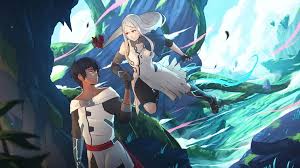As one of the most well-known card games available today for more than 20 years, Yu-Gi-Oh! has accumulated a remarkable collection of strong and recognizable cards. The monsters, spells, and traps that came to define the way the game was played and changed the TCG for years to come are the best Yu-Gi-Oh! cards, whether they are from the most recent current sets or the earliest booster packs.
Numerous Yu-Gi-Oh! cards from throughout the illustrious franchise’s history meet this requirement. These are only a handful of the most well-known creatures, incantations, and pitfalls from this lucky trading card game.
1. Dark Magician
Because of its prominent position in Yugi Muto’s deck, Dark Magician is among the most recognizable Yu-Gi-Oh! cards ever. Picture: Konami
Where better to begin a list of the greatest Yu-Gi-Oh! cards than with a reference to the legendary boss monster created by Yugi Muto? Yu-Gi-Oh! is synonymous with Dark Magician. In the early stages of the card game, before Synchro or Link monsters were introduced, a winning strategy might be as easy as imitating your favorite anime character.
YouTube video’s cover art
Some players still want to experience the same high that comes from using their favorite card to win, even though it may not be as strong as it previously was for fans of the original TV series who recall Yugi winning with his Dark Magician. Due to its widespread use, a number of support cards—including Magician Navigation—were developed to facilitate fans’ usage of this recognizable card.
While Dark Magician might not be the most competitive card in Yu-Gi-Oh! right now, it is an example of how a single card’s widespread appeal can keep it relevant as a dueling tactic for more than two decades.
2. Blue-Eyes White Dragon
Not only is Blue-Eyes White Dragon one of the greatest Yu-Gi-Oh! cards, but its original edition is also quite valuable. Picture: Konami
A list of the most recognizable Yu-Gi-Oh! cards would be incomplete without mentioning Seto Kaiba, Yugi’s adversary, and his boss monster, Dark Magician. Similar to Dark Magician, a whole archetype has emerged around it specifically to facilitate the summoning of this 3000 ATK boss monster. Monsters like The White Stone of Legend have been created specifically to ease the summoning and searching of this monster on the field.
Above all, though, Blue-Eyes White Dragon may take pride in being among the most valuable Yu-Gi-Oh! cards ever released. A first-edition copy of this rarest card to appear in the first Legend of Blue-Eyes White Dragon booster pack can fetch thousands of dollars at auction.
YouTube video’s cover art
Blue-Eyes White Dragon is an extremely formidable opponent in a duel, even when its monetary worth is taken into consideration. It should come as no surprise that, similar to the TV series, the Dark Magician vs. Blue-Eyes match-up was frequently reproduced in the game’s early duels.
3. Exodia The Forbidden One
Exodia is one of the strongest Yu-Gi-Oh! cards that have ever appeared in the TCG. The player who gathers all five parts of the fabled monster wins right away. Picture: Konami
Exodia was among the first Yu-Gi-Oh! cards to bring different win conditions to the TCG. If players draw all five pieces of Exodia, they can win the duel instantaneously thanks to The Forbidden One. Players promptly tried to assemble decks that would give them the best opportunity of getting these pieces as soon as possible, given the unusual nature of the win condition.
YouTube video’s cover art
Since the debut of this card years ago, a number of monsters that are similar to it, such Victory Dragon, have added new mechanics that let players win in ways other than reducing their opponent’s life points to zero. Still, few are quite as memorable or fulfilling as Exodia, one of the few Yu-Gi-Oh! cards with a special win condition that isn’t prohibited from being used in competitive play. Players continue to carry on its legacy by coming up with creative and novel ways to rotate through their decks in an effort to replicate the joy that comes from drawing all five pieces.
4. Pot of Greed
Pot of Greed was one of the greatest Yu-Gi-Oh! cards ever created, yet its straightforward card-drawing ability also resulted in its removal from the TCG. Picture: Konami
Pot of Greed is a banned Yu-Gi-Oh! card with a three-word effect that, despite its seeming simplicity at first, is one of the most potent and memorable in the game today. Pot of Greed was one of the few cards that any deck could play that would instantly grant access to new cards from your deck at no cost, back when the TCG was significantly slower than it is now.
Due to its versatility and flexibility to be included into any deck, the card was eventually outlawed for providing an unfair advantage. To provide comparable, more equitable variations on this powerful spell card., a whole line of “Pot” cards, such as Pot of Avarice or Pot of Prosperity, have been produced in the years that followed. Although players can still draw with these different Pot spell and trap cards, there is a cost associated with each. We’re not likely to see a free draw card quite like this one again.
5. Yata-Garasu
Yata-Garasu was another Yu-Gi-Oh! card that was outlawed because of its strong powers. It prevented your opponent from drawing cards, which frequently ended any opportunity they had to counterattack. Picture: Konami
Though it might not seem like much, Yata-Garasu is credited with introducing the Yu-Gi-Oh! banlist.. Who would have guessed that a simple bird with 300 ATK could cause such disruptions to the game that the developers were forced to remove the card from competitive play?
The main card in the Yata Lock deck that ruled early Yu-Gi-Oh! was Yata-Garasu. You could stop your opponent from playing the game by clearing their field and hand before using Yata-Garasu to summon and assault. Many players constructed decks specifically to keep their opponent from using their deck because of Yata-Garasu’s ability to force them to forego their Draw Phase if they sustained damage from this bird. Playing it was so disruptive that the card was immediately banned in 2004 and placed on the first restricted list, where it remains to this day.
6. Cyber Dragon
Because Cyber Dragon’s power enabled three World Champions win, competitive Yu-Gi-Oh! was changed. Picture: Konami
In addition to being a beloved card in the GX anime, Cyber Dragon is renowned for having revolutionized the gameplay of Yu-Gi-Oh! after its introduction in Cybernetic Revolution. It was far more difficult to summon a monster with more than 2000 ATK on your first turn back then because Special Summons were much scarce and the game moved much more slowly.
As a result, Cyber Dragon became the focal point of the game, and decks using it won the top spot at the Yu-Gi-Oh! World Championships for three consecutive years. After more than 15 years of development, the card is still useful in some rogue strategies in the current meta thanks to its new Link and Xyz support, as well as its ability to Special Summon itself if only your opponent owns a monster.
7. Crush Card Virus
Since Crush Card Virus was first intended as a prize card for tournaments, only few players have access to its potent ability. Picture: Konami Crush Card Virus illustrates the worst-case scenarios that arise when the strongest cards in Yu-Gi-Oh! are also the hardest to obtain. Less than 50 of these trap cards were made accessible to a select group of players who finished highly in official tournaments during the first half of 2007. This trap card initially made its appearance in the competitive arena as a prize card that was only available to the fortunate few who won an officially sanctioned tournament event.
YouTube video’s cover art
By enabling you to check your opponent’s hand and draw for the following three turns, Crush Card Virus effectively restricted their ability to play the game and destroyed any monster with more than 1500 ATK. Most decks could only hope to stall their opponent until this card’s effect wore off if they were hit by its effect. This card was so good that most top decks in big tournaments at the time featured at least one copy, even though it was extremely rare. Shortly after the card was made public through an official reprint, it was banned; only an erratum could remove it from the list of prohibited materials. It continues to be of the most potent prize cards in TCG history today.
8. Maxx “C”
Players took up a challenge to see how many cards they could Special Summon to have their opponent draw in a single turn in an attempt to compel them to lose by “deck out” after Maxx “C”‘s absurd card-draw effect. Picture: Konami
Maxx “C,” a cockroach that has the power to turn a fight around, presents an intricate puzzle that any opponent must solve when it is activated. The owner of this hand trap can draw one card each time their opponent Special Summons a monster by discarding it at any point during either player’s turn.
The Maxx “C” Challenge was created as a result. To stop your opponent from drawing more cards, do you hold back and end your turn? Or do you hold on, knowing full well that your opponent could at any moment draw the ideal counter or tool for their next turn? Some decks went one step farther and created a loop in which summons were made indefinitely, forcing the activating party to deck out and lose. Despite being prohibited in the TCG, this card’s extra tension makes it a fan favorite among Yu-Gi-Oh! enthusiasts.
9. Legendary Six Samurai – Shi-En
Remarkable Six Samurai: Shi-En contributed to the Six Samurai deck’s rise to prominence as one of Yu-Gi-Oh!’s most potent decks. Picture: Konami
The Six Samurai deck was able to overwhelm the board with monsters in a terrifying show of power during its peak thanks to the usage of Gateway of the Six and monster effects. But you required Legendary Six Samurai – Shi-En to turn that strength into a winning board.
View on YouTube
Because of how easily it could obtain the proper materials onto the field, Six Samurai decks found it easy to summon this Synchro monster, which was frequently essential in keeping your opponent from stopping your strategy. Shi-En offered the deck a method to negate any spell/trap card that might disrupt play, and only became more powerful in conjunction with Great Shogun Shien, limiting your opponent to one spell or trap card per turn. The negation abilities of Shi-En helped the deck become one of the most dominant decks in Yu-Gi-Oh! history, and is remembered fondly enough to ensure support for the archetype continues to this day.











































